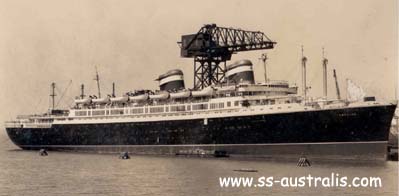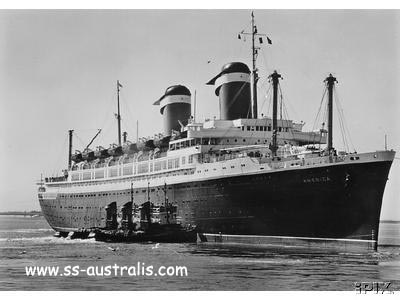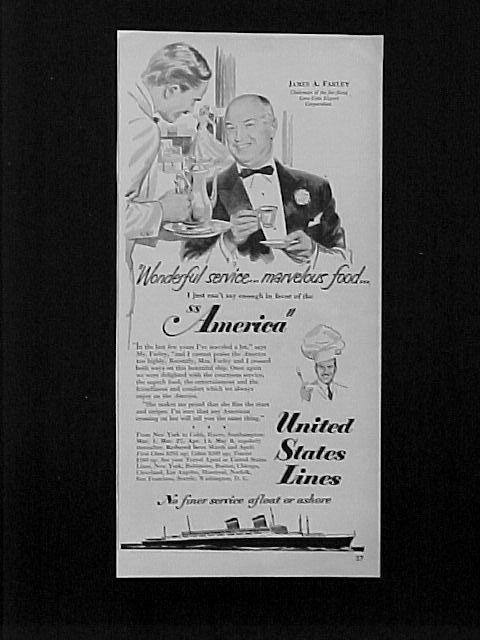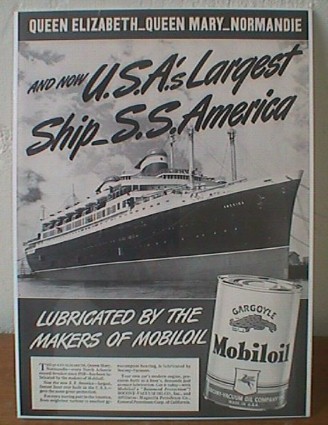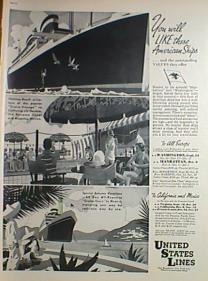United States Lines
“Those masts that stand so still in harbour will teeter through the sky. Those slant oval eyes near the crown of the bow will plunge into angry seas and stream with water and even that bridge will get a ducking” – New York Times
After the SS America was launched she needed to be fitted and for her seaworthiness tickets to be endorsed. She was originally designed to carry 543 cabin class, 418 tourist class and 241 third class passengers with a crew of approx 643. The propelling machinery consisted of 2 sets of triple expansion steam turbines producing 34,000 shp driving 2 four bladed screws. The machinery alone weighed some 2,514 tons. Possessing strikingly handsome lines, despite her bulk she was most dynamic in apperance as her tall prow was severely flared and had a slight clipper rake. The very streamlined superstructure rose 4 decks above the main deck and originated with a modern curved bridge. Topping her well proportioned superstructure were 2 squat funnels, oval in shape. Both funnels were finished with a ‘san-pan’ design, which proved so popular it was incorporated onto the SS United States and cargo ships of the same line as a “trademark”. The foremost funnel mounted behind her bridge was in fact a dummy funnel included to create a well balanced profile and housed an emergency generator.
America left the yard for her first time under the command of Captain Joseph Kemp and a ship yard crew of 500 at 4.00am on June 4th 1940 for her builders trials off Virginia Capes. Returning 24 hrs later she as given the ‘thumbs up’ and on the 9th June she set sail for dry docking at Boston Naval yard for painting of her underwater hull. Standardised navy trials set for the measured mile course off Rockland Maine were held on the 13th and 14th June 1940 followed by an 8 hour endurance run on which she averaged 24.68 kts and under full revolutions delivering a staggering 42,850 shp she reached 25.3 kts. She was returned to New Port News for some minor alterations and one major one. Her San Pan funnels were a huge flop and without publicity they were raised 15ft which in fact enhanced her appearance. The reason for them been raised was due to the smoke not dispersing properly and lingering in the aft accommodation area.
America’s internal appointments carried the stamp of all that was the ultimate in contemporary American design and decor. Although traditional features like brass work and paneling were there she was ahead of her time due to her designers using such as aluminium, stainless steel, ceramics and synthetic fibres. Of particular interest was her circular first class smoking room, gallied main lounge and a mosaiced indoor pool on C deck.
Her designers never used the word Titanic to say she was unsinkable but she was constructed with individual compartments and in theory was able to stay afloat in case of damage to 1 or more compartments. The America passed three compartment flooding standards, that been 3 of her 14 compartments reaching to her main deck could be flooded and she would remain afloat.
The America was powerful in appearance yet her funnel arrangements and kingposts (forward cranes) and short foredeck , gave her a somewhat squashed up front look.
‘Above all else you are sailing American seas, under the American flag on an American ship armed with nothing but the stars and stripes’
Philadelphia Newspaper August 24th 1940
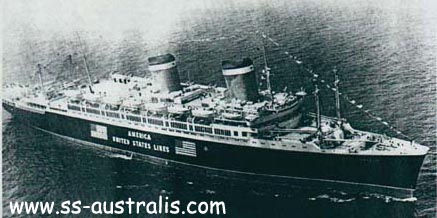
Now sporting her 15ft extensions 
The vessels final costs was $17,586,478 (us) and by the time she was ready for service the war in Europe had been underway for 9 months and therefore her maiden voyage needed to be cancelled and rechartered to neutral waters. As a safe guard against attack, in particular form the U boats the America’s hull was emblazoned with her name and a large American flag, and against all principles she steamed at night fully illuminated.
Philladelphia newspaper – August 24th 1940
On August the 5th the liner sailed at 10:00 am on the first of two, 10 hour cruises to nowhere, the first with 1,300 travel agents and the second with 1,500 freight agents. Her first maiden voyage was on August 10th 1940 with 775 passengers and a crowd of some 3,000 waving her off. The America returned on the 22nd August after a cruise to San Juan and although not the best of mauden voyages it was successful and triumphant.
During her cruises and amid naval ‘hush hush” security she was dry docked at Norfolk Naval Base on January 3rd 1941 and in addition to ‘regular maintenance’ she was fitted with a mine degausing cable. The first to be fitted to an American ship. This was fitted in a record 3 days instead of the normal 30 days.
Her first run through the Panama Canal was on February 4th 1941 and whilst on this trip called into San Francisco and had a staggering 11,400 visitors in one day.
As WWII closed around America, the SS America was requisitioned to the US Navy. Whilst on a cruise Capt Stedman whilst in St Thomas received the order on May 28th 1941 to Newport News to hand the America over to the United States Navy.
Click to move to her next chapter : USS WESTPOINT 1941 – 1946
